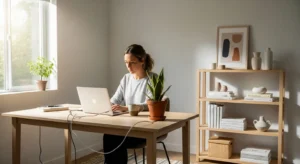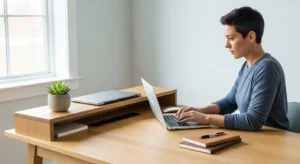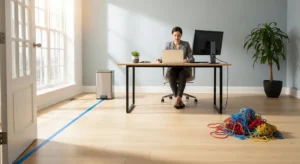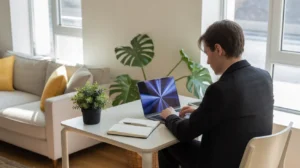
Look at your desk. Right now. What do you see? A stack of mail you mean to open, a few pens that may or may not work, a charging cable for a device you replaced last year, and a collection of sticky notes that have lost their stick. This isn’t just physical clutter; it’s a source of constant, low-grade distraction. At TheFocusedMethod.com, we call this visual friction. It’s the mental energy you expend every time your eyes scan over an object that is out of place, unfinished, or irrelevant. This friction is the silent killer of productivity and the enemy of a calm mind.
Many guides on creating a productive home office design focus on willpower—forcing yourself to be tidy, to put things away, to stay on task despite the chaos. But willpower is a finite resource. A truly effective system doesn’t rely on your mood or motivation. Instead, it builds a supportive environment where focus is the path of least resistance. The goal is not a stark, empty room, but a space where every single item serves a purpose and supports your work.
This guide will walk you through creating a minimalist home office setup that is not only beautiful and calm but also incredibly low-maintenance. We will focus on building simple, repeatable systems that manage clutter before it starts. By designing your environment with intention, you can spend less time managing your stuff and more time doing meaningful work. We will explore how to define your space, create effortless daily routines, and tackle common challenges like small apartments and paper backlogs. This is your blueprint for a workspace that works for you, not against you.
📚 Table of Contents
- Designing Your Environment: The Power of Zones and Flow
- Building a System: The Simple Habits of a Minimalist Office
- Minimalism in a Small Footprint: Strategies for Apartments and Shared Spaces
- Putting It Into Practice: Two Minimalist Makeovers
- Frequently Asked Questions About a Minimalist Home Office
- How do I tackle a massive backlog of paper I’ve accumulated over years?
- My partner or family isn’t on board with minimalism. How can I keep our shared space organized?
- What do I do with sentimental items that are cluttering my workspace?
- My “office” is a tiny desk in my bedroom. How can I separate work from rest?
- Your First Steps to a Focused Workspace

Designing Your Environment: The Power of Zones and Flow
The foundation of a sustainable minimalist office is not a frantic decluttering session; it’s a thoughtful approach to space and flow. Before you throw anything away, take a moment to understand how you actually work. The goal is to reduce the number of decisions you have to make throughout the day, freeing up precious mental bandwidth for complex tasks. This starts with creating clear, intuitive working zones.
A working zone is a designated area for a specific type of activity. Even in the smallest home office, you can create micro-zones. Your main desk surface should be your “deep work” zone, reserved for your computer, a single notebook, and the task at hand. A nearby shelf could be your “reference” zone, holding essential binders or books. A comfortable chair in the corner might be your “reading” zone, perfect for reviewing documents without the temptation of your keyboard. By physically separating tasks, you create mental boundaries that help you switch contexts more effectively and stay focused on one thing at a time.
Once you have a sense of your zones, the next step is to assign a permanent, logical home for every single item. This is the cornerstone of all organization. When an item has a designated home, you never have to ask, “Where should this go?” The answer is already decided. Your pens go in the desk drawer organizer. Your active project files go in the vertical file holder on your credenza. Your headphones hang on a small hook on the side of your monitor. This principle eliminates piles because a pile is simply a collection of homeless items—a monument to deferred decisions.
In a truly minimalist home office setup, you can also adopt a label-light approach. While some organizers advocate for labeling every single cord and folder, this can create its own form of visual noise and become a system that is too rigid to maintain. Instead, think in broad, intuitive categories. Use one simple box labeled “Cables” instead of ten tiny, individually labeled bags. Have a drawer for “Stationery” rather than separate compartments for paper clips, staples, and binder clips. This approach is more flexible and respects your brain’s ability to remember where general categories of items belong. The goal of a productive home office design is simplicity, not complexity. By creating clear zones and assigning homes to your belongings, you build an environment that guides you toward order naturally.

Building a System: The Simple Habits of a Minimalist Office
A perfectly organized desk is useless if it descends into chaos within a week. The magic of a minimalist office isn’t in the initial setup; it’s in the simple, embedded habits that keep it that way. Lasting change comes from small, consistent actions, not from grand, one-time efforts. Here, we’ll introduce a few core systems—reset points, the one-touch rule, and digital hygiene—that form the engine of a low-maintenance, productive workspace.
First, establish your reset points. A reset point is a designated time or trigger for a quick, routine tidying of your space. The most powerful reset point is the end of the workday. Before you close your laptop and transition into your personal life, take just five to ten minutes to reset your office. Put away papers, return books to the shelf, wipe down your desk, and straighten your keyboard. This small ritual does two things: it ensures you start every morning with a clean, inviting workspace, and it creates a psychological boundary, signaling to your brain that the workday is officially over. Another potential reset point could be just before your lunch break. The key is to make it a non-negotiable part of your schedule, like brushing your teeth.
Next, integrate the one-touch rule into your workflow. This is a simple but transformative habit for preventing clutter, especially paper and digital files. The rule states: whenever you touch an item, you must deal with it completely in that moment. When a piece of mail comes in, you don’t put it on the desk to “deal with later.” You immediately open it, decide what to do with it—pay it, file it, or recycle it—and complete the action. The same applies to your digital life. When you download a PDF, don’t leave it in your “Downloads” folder. Immediately rename it with a clear, searchable title and move it to its permanent home, whether that’s an “Active Projects” folder or a “Reference” archive. This habit single-handedly eliminates the backlogs that cause so much stress and visual friction.
Finally, your physical home office is only half the battle. Digital clutter can be just as distracting. Apply minimalist principles to your computer’s desktop and file system. Keep your desktop almost completely clear, with only the files for the project you are actively working on today. Everything else should live within a simple, streamlined folder structure. A good starting point for many is a four-folder system: 1_Inbox (for items to be processed, which you clear daily), 2_Projects (with a subfolder for each current project), 3_Reference (for archived material and general information), and 4_Archive (for completed projects). A weekly digital reset, where you spend fifteen minutes clearing your desktop, organizing your inbox folder, and ensuring files are in the right place, will keep your digital environment as calm and productive as your physical one.

Minimalism in a Small Footprint: Strategies for Apartments and Shared Spaces
The dream of a dedicated room for a home office is a luxury not everyone can afford. Many of us are carving out workspaces in the corners of living rooms, bedrooms, or even kitchens. The good news is that minimalist principles are even more powerful when space is at a premium. A productive home office design in a small or shared space is all about visual containment and clear boundaries.
If you live in a small apartment, your primary strategy should be to think vertically and embrace multi-functionality. Instead of a wide, sprawling desk, consider a narrower secretary desk that can be closed up at the end of the day, hiding your work from view. Use wall-mounted shelves to get papers and supplies off your limited desk surface. Look for furniture that can serve dual purposes. An elegant console table can function as a desk during the day and a decorative surface in the evening. The goal is to minimize the physical and visual footprint of your work, allowing the space to feel like a home first and an office second.
In a shared space, such as a living room you share with a partner or family, psychological boundaries are as important as physical ones. The key is to “contain” your work. Use a simple, elegant tray to hold your laptop, notebook, and pen. At the end of the day, you can pick up the entire tray and move it to a bookshelf, instantly clearing the shared surface. A lidded box or a set of beautiful magazine files can serve the same purpose, holding all your work-related items so they don’t visually bleed into the shared living area. This containment strategy reduces friction with others and helps you mentally disconnect from work when you’re done for the day.
Creating a minimalist home office setup doesn’t have to be expensive. You can achieve a clean, organized look with simple, low-cost storage solutions. Instead of custom cabinetry, consider basic, modular shelving from a retailer like IKEA. Plain cardboard or fiberboard boxes are excellent for storing cables, extra office supplies, and archived files on shelves. You can find minimalist-designed stationery holders, trays, and file sorters from brands like Muji or even at your local office supply store. The focus should be on clean lines, neutral colors, and closed storage. A few simple, matching boxes on a shelf will always look calmer and more organized than a jumble of mismatched items, no matter how inexpensive they are. The investment is in the system, not necessarily in high-end furniture.

Putting It Into Practice: Two Minimalist Makeovers
Theory is helpful, but seeing these principles in action makes them tangible. Let’s walk through two common scenarios and apply a minimalist systems-based approach. We’ll look at a dedicated but cluttered home office and a makeshift “command center” on a kitchen counter.

Mini-Makeover 1: The Dedicated Home Office
The Before: Sarah has a spare room for her office, but it has become a dumping ground. The desk is covered in three distinct piles of paper: “Urgent,” “To File,” and “Maybe Important.” Her bookshelf is a chaotic mix of business books, old binders, and decorative objects. Cables for various chargers create a “spaghetti” effect behind her monitor. She feels overwhelmed the moment she walks in, and her productivity suffers.
The Minimalist System: We start not by decluttering, but by defining zones. Her desk is now the “Deep Work Zone” and is to remain clear except for her laptop, a single notebook, and a lamp. We establish a “Processing Zone” on a small side table. Here, we place a single, three-tiered inbox tray: Action, Waiting, and File. This immediately gives the homeless papers a system. The bookshelf becomes the “Reference Zone.” We remove the decorative items and replace them with five identical, label-light magazine files: Finances, Clients, Projects, Marketing, and Ideas. All the loose papers from the “To File” pile are sorted into these. Finally, we tackle the cables. We use simple velcro ties to bundle them and an adhesive cable clip to run them neatly along the back of the desk. As a final step, we institute a 10-minute end-of-day reset. Sarah now spends the last few minutes of her workday clearing her desk, processing anything in her “Action” tray, and ensuring the room is ready for a focused morning. The result is a calm, productive home office design that supports her work instead of distracting from it.
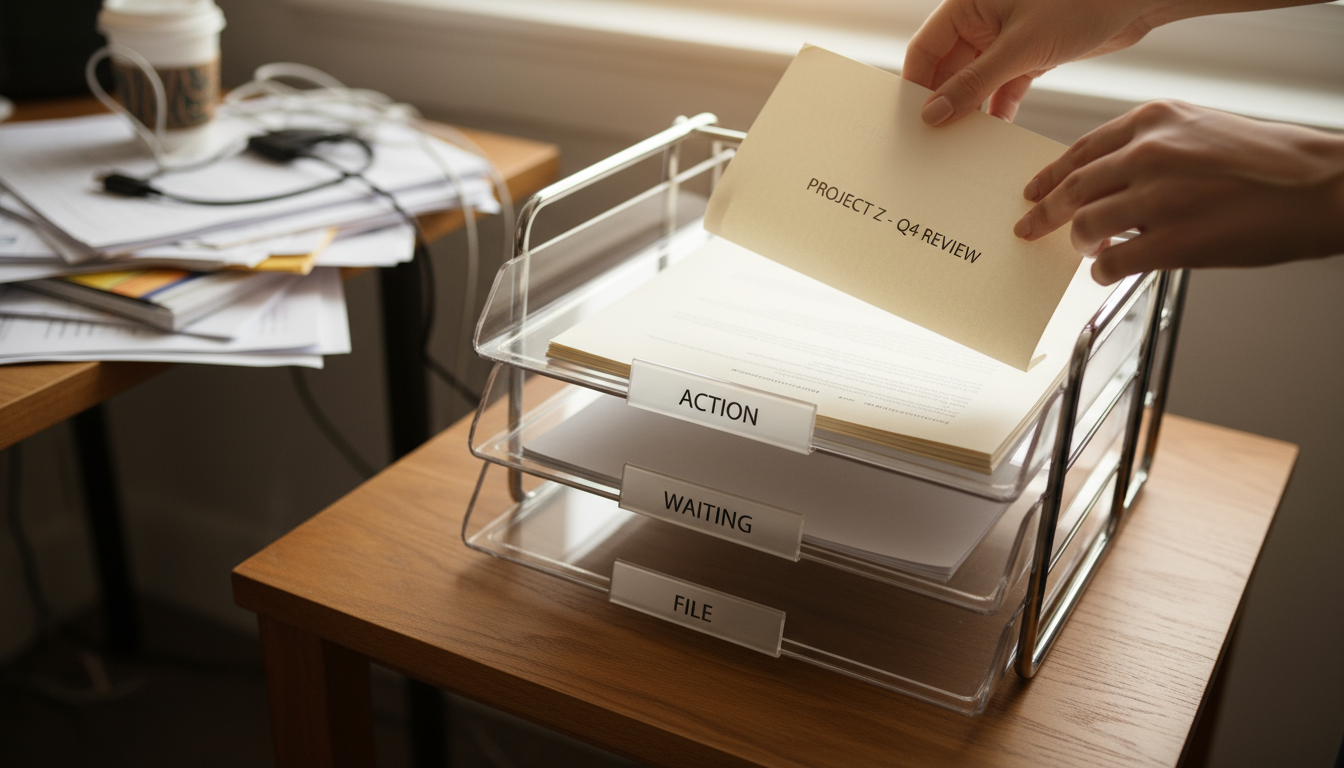
Mini-Makeover 2: The Kitchen Command Center
The Before: Mark’s family uses a section of their kitchen counter as the family hub. It’s constantly cluttered with mail, school permission slips, keys, charging phones, and random odds and ends. It’s a major source of visual friction in the heart of their home, and important papers often get lost or stained with coffee.
The Minimalist System: Since this is a shared, high-traffic area, the solution must be incredibly simple and easy to maintain. First, we get everything off the counter. We install a sleek, wall-mounted mail sorter with three slots: Incoming, Action (for bills to pay and forms to sign), and Filing. This immediately clears the paper clutter. Next, we create a “Charging Zone” inside a nearby drawer. We use a small power strip and short cables, so phones and devices can be charged out of sight. A small, decorative bowl is placed on the counter right by the door, creating a designated “Landing Zone” for keys and wallets. This gives these items a clear home the moment someone walks in. Finally, a small, magnetic dry-erase board is placed on the refrigerator for reminders and notes, eliminating the need for paper scraps. The family agrees to a two-minute “counter reset” every night before bed, where they put items in their new homes. This simple setup transformed a chaotic counter into a functional, streamlined command center.

Frequently Asked Questions About a Minimalist Home Office
Transitioning to a minimalist office often brings up practical questions. Here are answers to some of the most common challenges people face when implementing these systems.
How do I tackle a massive backlog of paper I’ve accumulated over years?
A huge paper backlog can feel completely paralyzing. The key is to not try to conquer it all at once. Instead, schedule dedicated, bite-sized sessions. Set a timer for 25 minutes and work on one pile or one box. Use a simple sorting system: Toss/Recycle, Action, and File. Be ruthless with the first category—get rid of old utility bills, expired coupons, and irrelevant marketing mail. For the “Action” pile, create a simple list of tasks (e.g., call the bank, pay the invoice) and schedule time to do them. For the “File” pile, create broad categories and file them away. The goal is progress, not perfection. Even one 25-minute session per week will make a significant dent over time.
My partner or family isn’t on board with minimalism. How can I keep our shared space organized?
You can only control your own actions and your own space, so start there. Create a pristine minimalist zone for your own work. Often, when family members see the calm and ease your system creates, they become more curious and open to change. For shared areas, focus on creating clear, agreed-upon boundaries and “containment” systems. A basket for each person’s clutter in the living room, a designated shelf for each person’s papers. Frame the conversation around shared benefits, like “Wouldn’t it be nice if we could always find the car keys?” or “I feel so much more relaxed when the kitchen counter is clear.” Lead by example and communicate with calm, collaborative language.
What do I do with sentimental items that are cluttering my workspace?
A minimalist office is not a sterile one; it should have personality. However, a workspace is not the right place for a large collection of sentimental objects, as they can be distracting. The first step is to choose with intention. Select one or two truly meaningful items to display—a single framed photo, a beautiful pen from a loved one, a small plant. For the rest, consider digitizing them. Take high-quality photos of your children’s artwork or scan old letters and save them in a digital “Memories” folder. For physical items you can’t part with but don’t need to see daily, store them safely in a designated memory box outside of your immediate workspace.
My “office” is a tiny desk in my bedroom. How can I separate work from rest?
This is a critical challenge for mental well-being. The most important tool here is the end-of-day reset. Having a clear, non-negotiable routine to “close down the office” is essential. This means putting your laptop away in a drawer or bag, filing any papers, and clearing the desk surface completely. If possible, use furniture that can be closed, like an armoire desk or a secretary desk. If not, even throwing a simple, beautiful cloth over your monitor and keyboard can create a powerful visual cue that the workday is over. Avoid working from bed at all costs, as this blurs the boundary between your resting space and your workspace, which can negatively impact sleep quality.
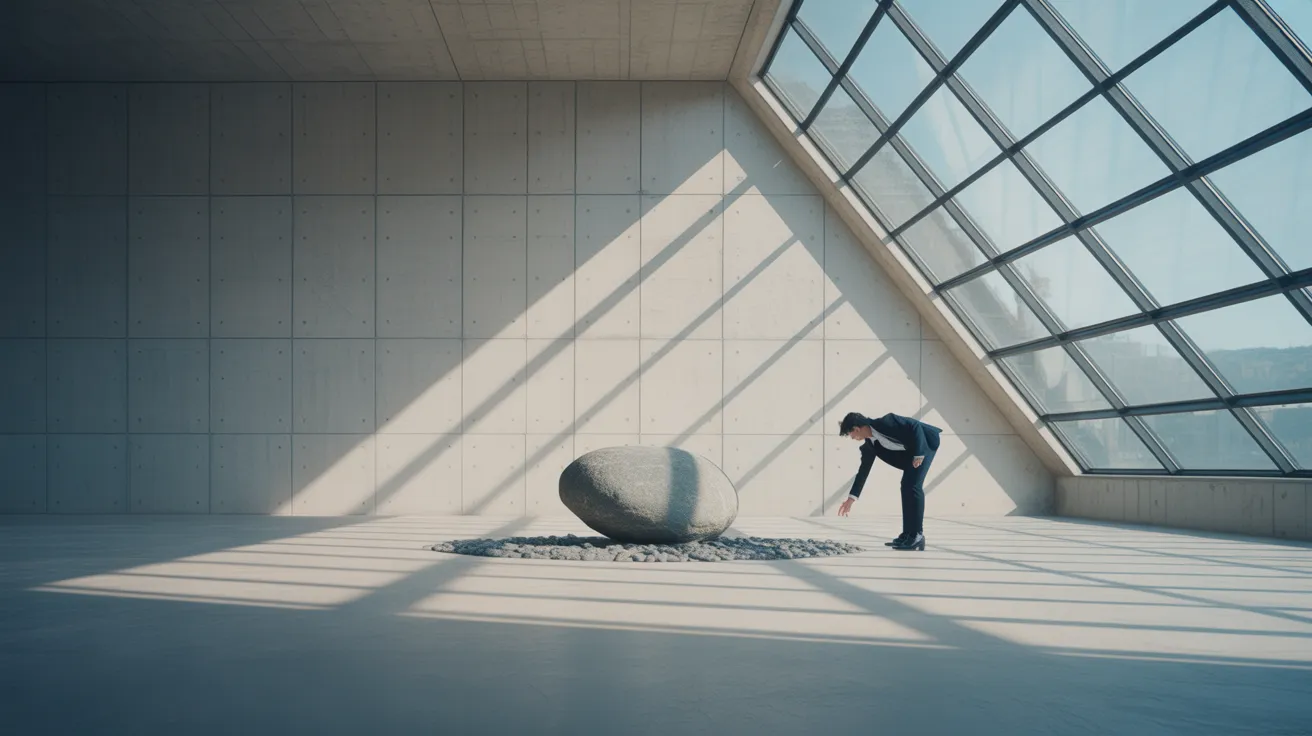
Your First Steps to a Focused Workspace
Creating a minimalist home office is not a one-time project; it is an ongoing practice of building better systems. The goal is to design an environment that gently nudges you toward focus and calm, reducing your reliance on fleeting willpower. By defining zones, establishing simple reset habits, and containing your work, you remove the visual friction that drains your energy and clouds your thinking. This is how you build a truly productive home office design—one that is sustainable, serene, and customized to the way you actually work.
You don’t need to overhaul your entire space this weekend. The best way to start is with a few small, intentional changes. Choose one or two of the reset actions below and commit to practicing them for the next week. Notice how they impact your focus and your state of mind. Small, consistent steps are what build the foundation of a lasting system.
Your Three Resets for This Week:
1. The Surface Reset: Tonight, before you finish work, take ten minutes to clear everything off your desk surface except your absolute essentials (monitor, keyboard, lamp). Put everything else in a single box to sort through later. Work on this clear surface for one day and see how it feels.
2. The Inbox Reset: Designate one physical tray or one digital folder as your “Inbox.” For the next week, make it a rule that all new incoming items—mail, notes, downloaded files—must go directly into this inbox. Schedule just 15 minutes each day to process it down to zero using the one-touch rule.
3. The Boundary Reset: Define your end-of-workday ritual. It could be as simple as wiping down your desk, closing all work-related tabs, and putting your notebook in a drawer. Set an alarm for 5 PM (or your chosen end time) and perform this small ritual every day. This creates the psychological closure you need to truly disconnect and recharge.
Welcome to a calmer, more focused way of working. Welcome to your new minimalist office.
Disclaimer: The information provided in this article is for informational purposes only and does not constitute professional, financial, or legal advice. Please consult with a qualified professional for advice tailored to your specific situation.
For expert guidance on productivity and focus, visit Getting Things Done (GTD), OSHA Ergonomics and National Institutes of Health (NIH).

